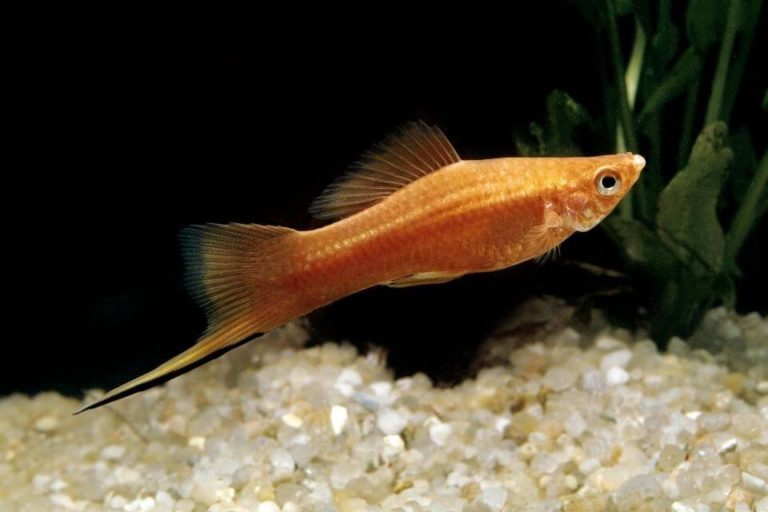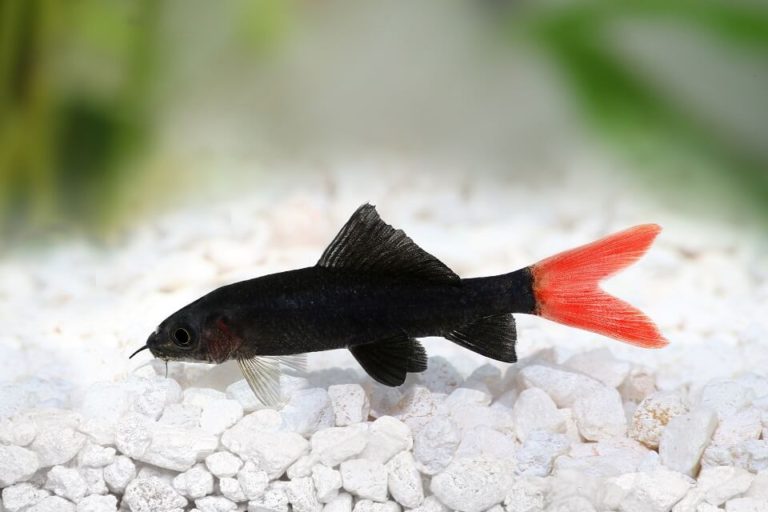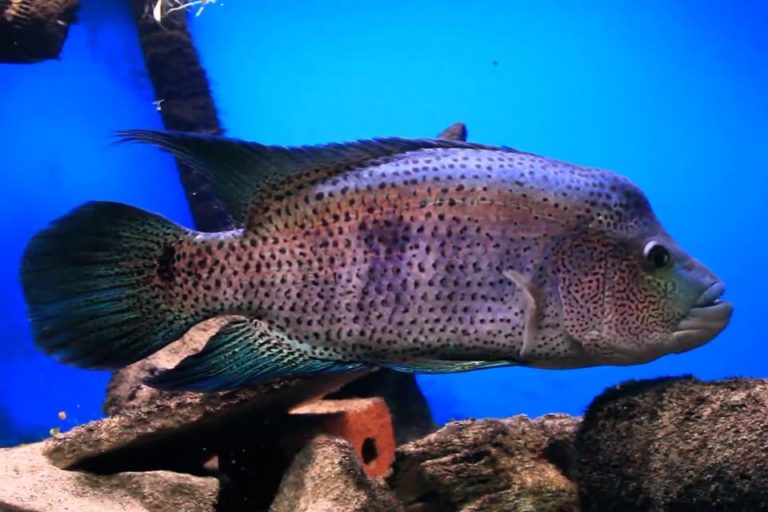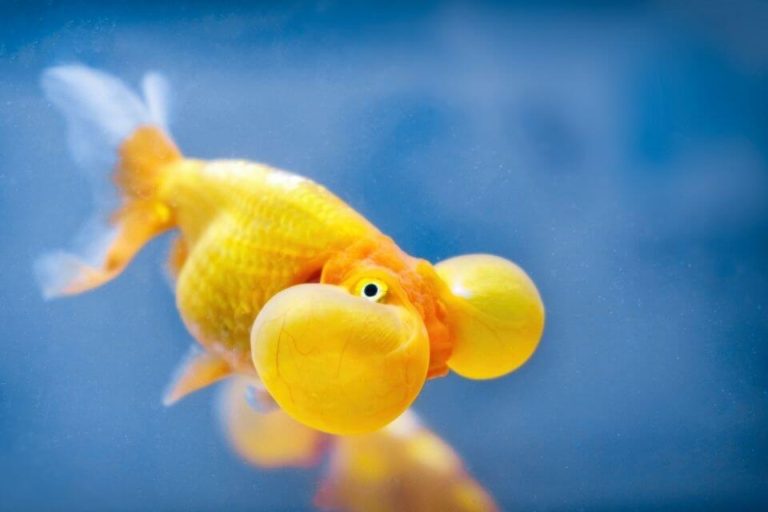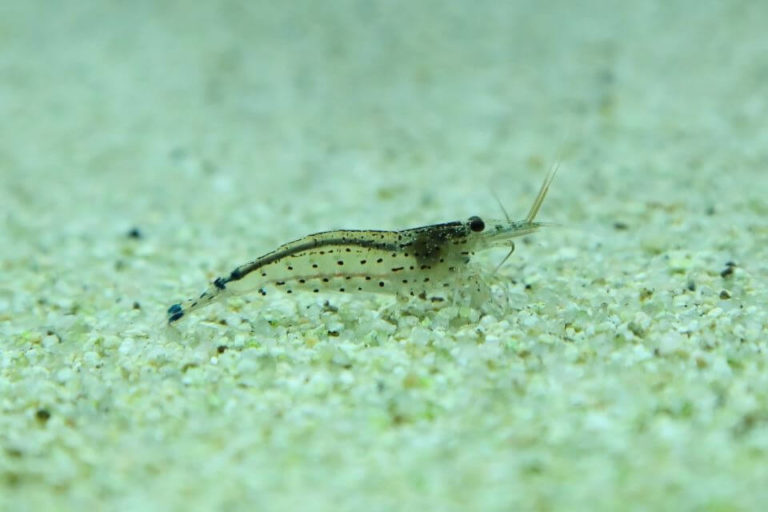Electric Blue Acara Care Guide: Tank Mates, Breeding, Tank Size & Setup
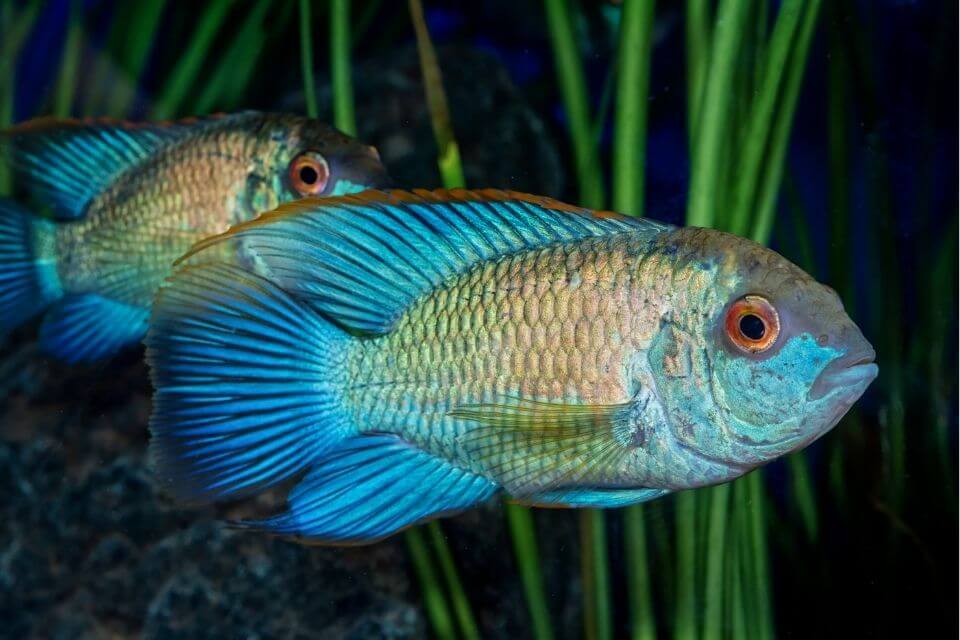
A stunning and peaceful fish, the Electric Blue Acara is a popular Cichlid for beginning and advanced aquarium keepers to enjoy.
This easily recognized freshwater fish is known for its gorgeous blue color as well as its peaceful temperament that makes it an easy fish for many environments.
If you are thinking of adding some Electric Blue Acaras to your tank, you’re in luck; these Cichlids are very easygoing and not too difficult to take care of.
They may be a bit more aggressive during the breeding season, but that may not be something you have to worry about. Electric Blue Acaras are friendly, hardy, and fun to watch.
They will get along with most fish in your tank, making them an excellent addition to aquariums large and small. Keep reading for an informative guide on the best ways to care for and maintain your Electric Blue Acara.
| Quick Facts: | |
|---|---|
| Common Names : | Electric Blue Acara |
| Origin : | Tropical water bodies in South East Asia |
| Family : | Cichlidae |
| Scientific Name : | Andinoacara pulcher |
| Care Level : | Easy |
| Temperament : | Peaceful |
| Social : | Community fish |
| Diet : | Omnivores |
| Size (average) : | Up to 7 inches long |
| Lifespan : | Up to 10 years |
| Breeding : | Egg layer |
| Minimum Tank Size: | 30 gallons |
| Tank Environment : | Freshwater, Sandy or gravel substrate, Rocks and Caves, Driftwood, Live aquarium plants (strong-rooted) |
| Temperature : | 68 – 82 °F (20 – 27 °C) |
| Water Hardness : | 2 - 20 dGH |
| Water pH Level : | 6.0 - 7.5 |
Overview of Electric Blue Acara
With a peaceful temperament and a long life, the Electric Blue Acara can give you years and years of success in your aquarium. You can find them at a relatively cheap price through most pet stores and fish distributors.
With no strong maintenance requirements or difficult-to-manage needs, the Electric Blue Acara is one of the top choices for aquarists who are just starting out.
This fish can add a new species to your tank without disrupting the harmony of the other creatures that may already live there. As a solid tank mate and a good sport, you should have the Electric Blue Acara on your team.
Electric Blue Acara Size
The size of Electric Blue Acaras is surprising to most. Many people believe that they are quite large like most other Cichlids. When they are young, they only reach a few inches in length. Keep in mind that they will continue to grow until adulthood.
– How Big Do Electric Blue Acaras Get?
The average Electric Blue Acara can grow up to 7 inches long when fully grown. This is not considered large, but it is a good mid-range fish if you have a small or medium-sized aquarium.
– How Fast Does Electric Blue Acaras Grow?
Electric Blue Acaras grow quickly when they are young, and as they age their growth starts to slow. By the time they are adults, they will have reached their maximum length and will not grow any further.
Electric Blue Acara Lifespan
A healthy Electric Blue Acara living in a well-maintained tank can be expected to live for up to 10 years. It is crucial that your fish are living in a comfortable environment under the right conditions so they can live to the full potential of their lifespan.
A clean tank can also prevent your fish from getting sick or contracting illnesses which may shorten their lives significantly.
Electric Blue Acara Typical Behavior
One of the many reasons why aquarists of all ages love the Electric Blue Acara is because this fish is so much fun to watch. As curious creatures, they usually swim around the middle or the bottom of the tank.
Their big eyes are always looking around, and they may even follow you if they see your movement outside of the tank. Due to their curious disposition, they can also be a bit shy.
You will find a healthy Electric Blue Acara engaging in a range of behaviors from hiding behind rocks to swimming fearlessly around the tank. This fish loves to settle at the base of plants and rocks, which is usually where you will find them resting.
Another behavior that sets this fish apart from most in its family is that it relies heavily on motherly care. The maternal fish will often be seen bringing food to their offspring and protecting fry from other fish in the tank.
This is important to note if you plan on breeding Electric Blue Acaras.

Electric Blue Acara Colors and Appearance
There is a reason these fish are named Electric Blue Acaras. From their beautifully bright bodies to their personality, there is a lot to enjoy about their physical appearance.
Their characteristics are what set them apart from all the others in your tank. The most noticeable feature of these fish is the predominantly bright blue coloring.
Young Electric Blue Acaras may be light blue, while older fish grow into the electric blue coat that gives them their namesake. However, do not be surprised if you spot other colors on this fish as well.
Most Electric Blue Acaras have gray or black colored heads, with the blue fading right before their eyes. Some of their fins may have an orange edging, which matches with the yellow, black, or white spots along their sides.
The darkness of their scales creates a net-like pattern that can be mesmerizing to look at.
Electric Blue Acara Care and Tank Setup
The most important part of keeping a healthy Electric Blue Acara – as is the case with all of your fish – is maintaining a good habitat.
The conditions of your aquarium can determine the health and long life of your fish, and it ensures a balance of harmony between the other creatures living in your tank.
The aquarium is home to your fish, and it is important to keep it clean so that they can thrive. Thankfully, it is not difficult to maintain good tank conditions for an Electric Blue Acara.
They can survive and adapt under a number of different conditions and generally like to live in temperate waters. Electric Blue Acaras come from the river basins and lakes of South America, which are heavily planted areas of calm waters.
In these basins, Cichlids like Electric Blue Acaras are almost completely safe from predators and other threats. They find these rivers to be rich for feeding, as the diversity of life is abundant.
You can recreate these conditions to help your fish continue to enjoy the bounty of life without putting themselves in danger.
This requires certain lighting, water, substrate, and plant conditions so that your Acaras will feel healthy. Keep reading for the details and specifications of keeping an aquarium sanitized and well-maintained.
Electric Blue Acara Tank Size
Electric Blue Acaras are not tiny fish by any means, and they are active swimmers. In order to keep them happy and healthy, you need a decently sized tank for them to swim around in.
If tank size is too small or too cramped, these typically peaceful fish can become quite aggressive.
With that said, it is important that you keep an Electric Blue Acara in a tank that is at least 30 gallons in size. If you plan on adding additional Acaras, plan for 15 gallons per extra fish.
Tank Setup
The best way to keep your fish healthy is to mimic their natural environment as much as possible. Because you will likely have plants and other fish in the tank as well, you want to invest in a good filtration system.
This is needed to aerate the plants and provide fresh oxygen to the tank. Filters also remove harmful particles and unclean substances from the water, keeping it as fresh as possible.
Your choice of substrate matters a lot with this species of fish. This fish loves to burrow in the ground to dig up nutrients and other sources of food.
Keep that in mind when selecting a substrate. Sand, gravel, and rounded pebbles can all be good choices for the bottom of the tank. You shouldn’t need more than a regular aquarium lamp to provide ample lighting for your fish.
These fish are used to many different types of lighting conditions, as heavily planted waters provide a lot of shade.
Suitable Plants
The Electric Blue Acara’s natural habitat contains many different species of plants. There are suitable floating plants as well as plants that can take root in the aquarium substrate.
These fish are used to seeing plants both in the water and on the surface, so you can feel free to mix it up with multiple plant species and types.
Some of the Electric Blue Acara’s favorite plants include:
- Java Fern
- Java Moss
- Vals
- Hornwort
- Floating vegetation
- Amazon Sword
- Anubias Nana
Electric Blue Acaras do not often eat plants, so you shouldn’t have to worry about whether or not you are adding unsafe plants to the tank.
However, it is important to keep in mind that other fish in your tank may eat them, so make sure you find plants that are suitable for all.

Water Conditions and Parameters
Keeping water clean and fresh is essential for the long life and happiness of your fish. Since Electric Blue Acaras are so adaptable, they can do well in many different temperatures and pH levels.
Keep an eye on the following specifics for a good starting point:
- Water Temperature: 68 to 82 °F (optimal ranges would be 75 – 76 °F)
- Water Hardness: 6 to 20 dGH
- Water pH Levels: Fairly neutral (pH level of 6.0 – 7.5)
Good quality water is the most important element of your tank. Dirty water can cause a variety of health issues for your fish, so it is important to change out at least 25% of your water every week.
Diet and Feeding for Electric Blue Acara
Your Electric Blue Acaras are generally peaceful and harmonious, but they can be vicious when it comes to feeding. As long as you can provide a steady and rich diet for them, they will not be prone to attacking or even harming your other fish.
As predators, Electric Blue Acaras enjoy meaty foods. They also enjoy a wide diversity of food, so make sure to spice up their meals with many of the following:
- Shrimp
- Bloodworms
- Mussel
- Vegetation
- Fish flakes
- Premade fish food (pellets or granules)
It is important to feed your Cichlids at least 2 to 3 times per day, as they will want to eat often. Make sure there is enough food in the tank for all of your Acaras to eat, but not so much that the leftover food will make others fight.
For an additional touch, you can invest in chemical supplements that add more nutrients to the food. But if you acquire fresh meat and certified food sticks, you should not need to add any more nutrition.
Electric Blue Acara Common Diseases
Electric Blue Acaras are very sturdy and stable, and you shouldn’t have to worry about any particular diseases. While these fish are not prone to illness, there are still a few common conditions and symptoms to be on the lookout for.
Ich
Ich is a skin-based bacterial disease that indicates dirty water. Your fish will develop patches on their skin and they will be seen itching themselves against rocks and plants.
You can add medication to the water to help them recover from this illness, but changing out your water is the best option.
Skin Flukes
Skin flukes are parasites that can take one of your fish as a host. The infected fish may suffer from illness, itchiness, or a lack of appetite. There are effective and safe treatments available to get rid of the parasites as quickly as possible.
Gender
Many people who own Electric Blue Acaras are excited about breeding them, and for good reason. They are fairly easy to breed, meaning you may have a lot of success with your attempts.
The first step in achieving successful breeding is to be able to properly distinguish the males from the females.
How Can You Tell if an Electric Blue Acara is Male or Female?
Male Electric Blue Acaras tend to be a little larger than the females, with brighter body colors and a hump shape on their heads. Females by contrast are smaller and sleeker, without a bump on the head.
Breeding Blue Acara
When it is time to breed your Electric Blue Acaras, make sure you add them to a separate tank. It should measure 20 gallons in size and contain fewer plants and substrates than the main tank.
Breeded Acaras usually remain in pairs, staying together for life. When these fish are ready to mate, you may see them spending a lot of time near the bottom of the tank.
Make sure you have rocks in your substrate as this is where they will want to be laying most of their eggs. The female will lay up to 200 eggs on the rocks, where she will remain to keep watch over them.
The male will also stay close to protect them, but he will also venture further out during this time. Egg incubation only takes a couple of days, after which some juvenile Acaras will start to show up.
It will take a few weeks of staying close to their mother before they are ready to be independent in their own aquariums.
Elecric Blue Acara Tank Mates
Unlike most other Cichlids, Electric Blue Acaras make for great tank mates because of their peaceful nature. One thing that is important to keep in mind is the size of your other fish, as larger fish will make Acaras more aggressive.
Stay away from very large or vicious fish. Also stay away from tiny fish, as the Blue Acaras may eat them. Some good suggestions for suitable tank mates include:
- Banded Cichlids
- Discus Fish
- Cory Catfish
- Rainbowfish
- Moga Cichlid
- Bristlenose Pleco
- Oscars
- Otocinclus
Don’t forget that the Electric Blue Acara is its own best tank mate! You can keep groups of these fish together and they will thrive peacefully with their own kind.
There are of course some fish that you should not keep with Electric Blue Acaras. Make sure to avoid aggressive fish such as:
- Angelfish
- Dwarf Cichlids
- Cichlasomas
It usually comes down to a matter of size and temperament. Use your best judgment when considering tank mates for your Acaras.

Origin, Distribution, and Availability
In the wild, Electric Blue Acaras are found swimming in the shallow rivers of Central and South America. They tend to prefer still lakes and calm waters, as opposed to other fish in the same family who like to swim in fast streams.
Any fish enthusiast will tell you that the Electric Blue Acara is a good species for keeping in a tank. These fish are quite adaptable, giving them a very large distribution range.
They survive well in most South and Central American countries, having lots of different calm water options to choose from.
Since they are such a popular choice for fishkeepers and aquarists alike, they are easy to find through most fish suppliers. They are distributed globally and are at no risk of becoming endangered.
Frequently Asked Questions
Is Blue Acara Aggressive?
Blue Acaras are very peaceful when living in your tank. The only time they would be prone to aggression is if there isn’t enough food in the aquarium, or the space is too small and crowded.
For the most part, these fish can easily get along with other species as well as their own kind. You can keep up to six Acaras together at a time, paired up in mating groups.
Can Electric Blue Acara Live with Angelfish?
It is not recommended to pair Blue Acaras with Angelfish. Angelfish are large and aggressive, meaning they will probably try to pick fights with your Acaras.
Electric Blues are unique Cichlids in that they prefer to be peaceful and usually have a harmonious temperament. Only under extreme conditions will Blue Acaras get aggressive.
You should never keep Angelfish and Electric Blue Acaras in the same tank.
Will Blue Acara Eat Tetras?
Most species of tetras are too small to peacefully share a tank with Electric Blue Acaras. They can also have personality conflicts. Tetras are aggressive, so these two species may fight over food or fish eggs.
What’s worse, your Acaras may end up eating the Tetras that are too small.
In order to preserve the peace of your aquarium and ensure the health and survival of all of the creatures within it, you should not place Tetras and Blue Aacaras in the same tank.
Can Blue Acara Live with Discus?
Discus can be a good tank mate for Blue Acaras. It largely depends on your tank setup and the other species in your aquarium, however. Discus requires high water temperatures as they are from more tropical parts of the world.
Blue Acaras can stand a little bit of warmth, but make sure it is not too much for them. There shouldn’t be fighting or aggression between these two species.
Do Electric Blue Acara Eat Plants?
As omnivores, Electric Blue Acaras will eat plants and just about any living thing. However, they tend to prefer meat. They can eat some floating vegetable matter, but you probably won’t find them nibbling on your plants.
They do like to dig them out of the substrate, however.
Will Blue Acara Eat Guppies?
Guppies should never be placed in the same tank as Electric Blue Acaras unless you tend to use them for feeding. In fact, guppies are one of the most recommended food types for your Acaras in order for them to get the meat and protein that they like.
Guppies are too small to be able to coexist peacefully with your Electric Blue Acaras.
What Do You Feed Electric Blue Acara Fry?
Blue Acaras are very good parents and will ensure that the fry gets all the food and nutrients that they need. In order to supplement their diet, you can start with some simple servings of worms and brine shrimp.
As they grow into fish, you can introduce some of the heartier elements of their diet.
How Long Does it Take for Blue Acara Fry to Grow?
Blue Acara fry can grow quickly, provided there is enough food and protein. Within a few days, you should start to see some juveniles swimming around.
The fry will grow to be about 1 inch in length after the first few months of life. These little ones will want to hang out with their mother until they are big enough to find food on their own.
Final Thoughts
The Electric Blue Acara can make a wonderful addition to any kind of freshwater aquarium. This peaceful fish is easy to get along with and easy to take care of.
If you are looking for a colorful and adaptable addition to your thriving community of fish, consider Electric Blue Acaras as a harmonious choice.
As long as you sustain their diverse diet and keep water conditions clean, you can enjoy an entire school of Acaras for many years to come.


